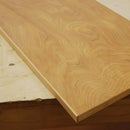Introduction: Applying Vinyl to Curved Surfaces
Applying vinyl to a surface with curved aspects can be tricky. Using a few simple tools and techniques can make this a much easier process. This Instructable will use a skateboard deck as the example surface, but the technique can be used for a variety of applications.
Tools and Materials Required:
-Vinyl
-Heat gun
-Knife or razor blade
-RapidTac or diluted soap solution
-Squeegee
Surface Preparation:
Before applying any vinyl, make sure the surface is clean and free of dust or dirt. The smoother the surface, the better the vinyl will look. Large imperfections should be removed where possible. This board was rough sanded with 60 and then 100 grit sandpaper. Small scratches won't be seen through the material if the vinyl is thick enough.
Step 1: Initial Surface Application
Cut the vinyl so that it is larger than the surface you wish to cover. Never cut the material to the exact dimensions or pattern before application. Once cut, roll the vinyl back up.
Thoroughly wet the surface with RapidTac or soapy water. Peel a few inches of vinyl from the backing paper, and adhere that section off the edge of the surface (in this case to the table). Pulling tension on the vinyl, begin applying to on the surface by removing the backing paper and laying it down. Follow the roll with a squeegee to keep the vinyl smooth. If wrinkles occur, peel the vinyl until they disappear, apply more RapidTac or soapy water, and continue as before. Keep going until the entire surface is covered.
Initial application tips:
-Apply the vinyl slowly.
-It helps to hold the roll close to the surface, as more tension can be pulled in this manner.
-Push the squeegee in the direction of the application, and keep it near the roll. This will allow the vinyl to remain fairly smooth as you lay it down.
Step 2: Stretching the Vinyl
In order for the vinyl to conform to the other contours in the surface (the wheel wells on the board), a heat gun must be implemented. Do this in sections. Lift the vinyl and apply heat directly above the portion to be stretched. Once the vinyl becomes pliable (it will take just a few seconds), pull tension to fit it into the curve. This process causes the vinyl to become thinner in that area, so be careful not to let it tear. Repeat this until the material has conformed to the entire surface.
Upon finishing this step, it is important to let the adhesive on the vinyl cure. Let it sit for at least 15 minutes before trimming and handling.
Step 3: Trimming the Vinyl
After the adhesive is set, you can begin to trim the vinyl. Start by cutting most of the excess material away, leaving about one to two inches of vinyl around the edge. Place the blade of the utility knife at an angle to edge of the board. Trim the remaining excess by slowly moving the knife around the edge. Be sure to hold the trim away from the surface to avoid having it stick. Holding the trim away as you move will also give you a cleaner cut.
Once the vinyl is flush with the edges, you're finished! You can either stop here, or add custom designs.
Step 4: Applyling Decals to the Surface
Start again by wetting the surface with RapidTac or soapy water. Using transfer paper, position the image made on TechShop Menlo Park's vinyl cutter, and applying light pressure, smooth it out with your hands. Run a squeegee across the entire surface to squeeze out the RapidTac. Allow the vinyl to sit for a minute or two, and then slowly peel off the transfer paper. If the vinyl is still sticking to the paper, simply lay it back down and press the squeegee firmly over the problem area. Repeat the process for the remaining decals.
After the last of the decals is applied, gently wipe the surface dry with a clean cloth. Trim any overhang flush to the edge with the knife, and you're finished.













